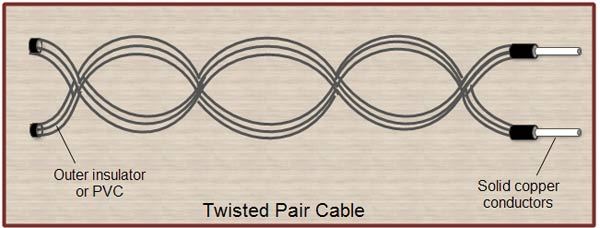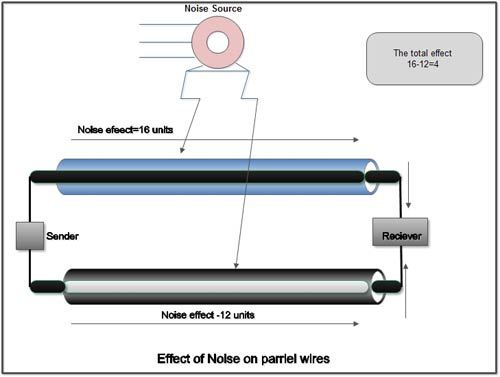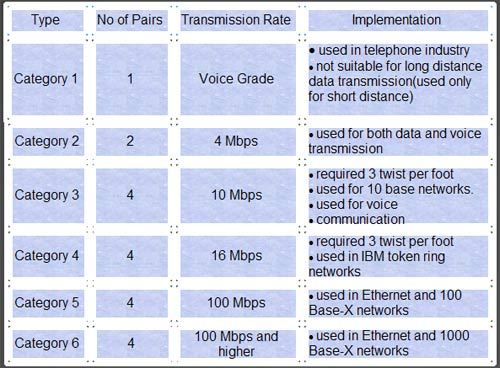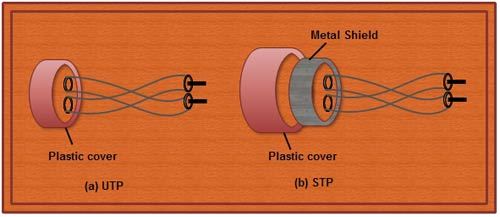The pair of twisted is the simplest transmission medium. it consists of one or more pairs of electrical son arranged spiral. This type of support is suitable for transmission both analog and digital.
The twisted pairs may be shielded, metal sheath surrounding completely metallic pairs or unshielded. They can also be “unscreened”. In this case, a metal tape around the son.
Numerous debates take place about the advantages and disadvantages of the shielding of these cables. We can say, simplifying, a shielded cable should be better able to immunize transported signals. The disadvantage of the shield is however that it requires the grounding of the whole equipment, since the physical support to the terminal. This requires that all land connection string is properly carried out and maintained. In other words, a shielded network must be very good, otherwise it may behave worse than an unshielded network, much cheaper.
metal cable are particularly suitable for the transmission of information on short distances. If the length of the wire is small, a few hundred meters to several kilometers, speeds of several megabits per second can be achieved without unacceptable error rate. Over shorter distances, can be obtained without difficulty speeds of several tens of megabits per second. On even short distances, it is easily reached several hundred megabits per second.
A distance of about 100 m allows to increase the throughput to several gigabits per second.
Standardization in the field of cables is performed by the group ISO /IEC JTC1/ SC25/WG3 international and national organizations such as the TIA / EIA (Electronic Industries Association/Telecommunications Industries Association) in the United States.
The main categories of cables laid are:
• Category 3 (10BaseT)
• Category 4 (10BaseT and Token-Ring 16 Mbit / s);
• Category 5 (10BaseT, Token-Ring 16 Mbit/s and 100 Mbit/s TPDDI)
• Category 5e (Type R evolved to a 100 MHz bandwidth);
• Category 6 (for a 200 MHz bandwidth);
• Category 7 (for a bandwidth of 600 MHz).
It is possible to compare the twisted pairs according to their crosstalk, that is to say the loss of part of the energy of the signal due to the proximity of another circuit and its attenuation.
A twisted pair consists of two copper wires about 1 mm thick.
• These two wires are individually contained in a plastic insulation and are twisted together in a helical form.
• Polyethylene, polyvinyl chloride, flour polymer resin and Teflon(r) are some of the substances that are used for insulation purposes.

• Purpose of twisting the wire is to reduce the electrical interference from the similar pairs in surroundings. The performance of the wire improves with the increase in the number of twist per foot.
• If the two wires are parallel, then the electromagnetic interference from the devices such as motor can create a noise or interference on the wire that is closer to the source of noise. This results in high voltage level in one wire than the other. 

• This further leads to uneven load and damaged signal and there will be difference at the receiver side.
• If two wires are twisted, then the cumulative effect of the interference on both the wires is equal.
• In such a way, each wire is closer to the noise source for half of the time and farther away for the other half i.e. in one twist one wire is closer to the noise source and the other is farther; in next twist the reverse is true.
• In this way, there will be no difference at the receiver side as unwanted signals are cancelled out.
• An Important property of twisted pair is its gauge. Gauge is a measure of thickness of the conductor. The thicker the wire the less the resistance, the stronger the signal over a given distance and the better the performance of the medium.
• The effective bandwidth of twisted pair depends on several factors including, the gauge of the conductor, and the length of the circuit and the spacing of the amplifiers (repeaters).
• Twisted pair can be used for transmitting either analog or digital signal and frequency range for twisted pair cable is 100 Hz to 5 MHz.
• The most common application of twisted pair cable IS m telephone system.
• Twisted pair is distance limited. As distance between network element increases, attenuation increases and quality decreases at a given frequency.
• Twisted pair is an insecure transmission medium. It is relatively simple to place physical taps on UTP.
We’ll be covering the following topics in this tutorial:
Types of Twisted Pair
The two types of twisted pairs are:
1. Unshielded twisted pair (UTP)
2. Shielded twisted pair (STP)
Unshielded Twisted Pair (UTP)
• It consists of color-coded copper wires, but does not include any foil or braiding as insulator to protect against interference.
• Wire pairs within each cable have varied amounts of twists per foot to produce cancellation.
• There are different categories of UTP.
• The following table shows the UTP categories, the no. of pairs in each, and the grade of cable each uses and how they are implemented.

Shielded Twisted Pair (STP)
• STP is made up of pairs of copper wires that are twisted together.
• The pairs are covered in a foil or braided mesh, as well as outer PVC jacket.
• This foil or mesh prevents the penetration of electromagnetic noise and eliminate cross talk.
• This shielding must be grounded to prevent the foil or braided mesh from becoming a magnet for electricity.

Why to twist the wires?
• Twisting of wires will reduce the effect of noise or external interference.
• Number of twists per unit length will determine the quality of cable. More twists means better quality.
Advantage of STP over UTP
STP is less susceptible to noise as compared to UTP and therefore reduces the cross talk and interference.
Disadvantages of STP
1. It must be properly grounded.
2. It is more expensive than UTP.
3. It is difficult to terminate.
Advantages of Twisted pair cable
1. It can be used to carry both analog and digital data.
2. It is relatively easy to implement and terminate.
3. It is the least expensive media of transmission for short distances.
4. If portion of a twisted pair cable is damaged it does not effect the entire network.
Disadvantages of Twisted pair cable
1. It offers poor noise immunity as a result signal distortion is more?
2. Attenuation is very high.
3. It supports lower bandwidth as compared to other Medias. It supports 10 mbps upto a distance of 100 meters on a 10BASE-T.
4. It offers very poor security and is relatively easy to tap.
5. Being thin in size, they are likely to break easily.
Applications of Twisted Pair Cables:
Some of the applications of twisted pair cables are as follows:
(1) In telephone lines to carry voice and data channels.
(2) In the local loop.
(3) In the DSL line (ADSL)
(4) Local area networks such as 10 Base-T and 100 Base-T. Use the twisted pair cables.
(5) In the ISDN (Integrated Services Digital Network).
Note:
• Category 1 and 2 cables were originally used for voice communication with low data rates.
• Category 4 offers data rates upto 20 mbps.
• A modular RJ-45 telephone connector is used to connect a four-pair cable.
• A modular RJ -11 telephone connector is used to connect a two pair cable.
• Shielded twisted pair (STP) cables were introduced by IBM Corporation.
General Properties of Twisted Pair
• Gauge is a measure of the thickness of the conductor. The thicker the wire, the less the resistance, the stronger the signal over a given distance, and the better the performance of the medium. Thicker wires offer the advantage of greater break strength. The gauge numbers are retrogressive. In other words, the larger the number, the smaller the conductor.
• Configuration In a single pair configuration; the pair of wires is enclosed in a sheath or jacket, made of polyethylene, poly vinyl chloride or Teflon. Usually, multiple pairs are so bundled as to minimize deployment costs associated with connecting multiple devices (e.g. electronic PBX or KTS telephone sets, data terminals, and modem) at a single workstation.
• Bandwidth The effective capacity of twisted pair cable depends on several factors, including the gauge of the conductor, the length of the circuit and the spacing of the amplifiers (repeaters). One must also recognize that a high-bandwidth (high frequency) application may cause interference with other signals on other pairs in close proximity.
Error Performance Signal quality is always important, especially relative to data transmission. Twisted pair is susceptible to the impacts of outside interference, as the lightly insulated wire act as antennae and, thereby, absorbs such errant signals. Potential sources of Electromagnetic Interference (EMI) include electric motors, radio transmissions and fluorescent light boxes. As transmission frequency increases, the error performance of copper degrades significantly with signal attenuation increasing approximately as the square root of frequency.
• Distance Twisted pair is distance limited. As distance between network element increases, attenuation (signal loss) increases and quality decreases at a given frequency. As bandwidth increases, the carrier frequency increases, attenuation becomes more of a issue, and amplifiers (repeaters) must be spaced more Closely.
Security Twisted pair is inherently an insecure transmission medium. It is relatively simple to place physical taps on UTP. Additionally, the radiated energy is easily intercepted through the use of antennae or inductive coils, without the requirement for placement of a physical tap.
Cost The acquisition, deployment and rearrangement costs of UTP are very low, at least in inside wire applications. In, high-capacity, long distance applications, such as interoffice trucking, however, the relative cost is very high, due to the requirements for trenching or boring, conduit placement, and splicing of large multi pair cables. Additionally, there are finite limits to the capacity and other performance characteristics of UTP, regardless of the inventiveness of technologists. Hence, the popularity of alternatives such as microwave and fiber-optic cable.
Applications UTP’s low cost including recently developed methods of improving its performance has increased its application in short-haul distribution systems or inside wire applications. Current and continuing applications include the local loop, inside wire and cable and terminal-to-LAN. Generally speaking, UTP no longer is deployed in long haul or outside the premises transmission systems.
 Dinesh Thakur holds an B.C.A, MCDBA, MCSD certifications. Dinesh authors the hugely popular
Dinesh Thakur holds an B.C.A, MCDBA, MCSD certifications. Dinesh authors the hugely popular